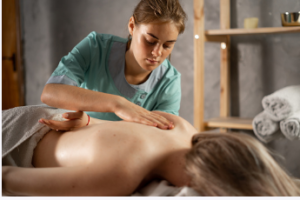Yates-Physiotherapy remedial massage Adelaide is a hands-on therapy that targets damaged, knotted, or tense muscles. It can assist with many health conditions involving muscles, tendons and bones.
 Remedial massage therapists possess extensive training in musculoskeletal anatomy and utilise specific techniques to manipulate soft tissue within the body. These can range from deep or gentle pressure points that target particular areas of pain, stiffness and tightness.
Remedial massage therapists possess extensive training in musculoskeletal anatomy and utilise specific techniques to manipulate soft tissue within the body. These can range from deep or gentle pressure points that target particular areas of pain, stiffness and tightness.
Improved Blood Flow
Yates-Physiotherapy remedial massage Adelaide helps to improve blood flow throughout the body by pinching and pulling muscles and tendons, flushing out lactic acid, and stimulating lymph fluid to transport metabolic waste away from muscles and organs.
Additionally, exercise helps release endorphins and oxytocin that promote feelings of relaxation. These hormones reduce anxiety and tension within the body, providing improved sleep at night.
Massage techniques stimulate the heart’s pumping system by increasing blood volume in the circulatory system, leading to improved venous and arterial flow to muscle tissues. Furthermore, this blood is packed with essential nutrients like oxygen and amino acids, which nourish muscles and enhance their functionality.
Massage techniques use pressure to increase blood flow by pushing through congested areas and releasing that pressure so fresh blood can enter, providing new nutrients to muscle tissue.
Massage also aids blood flow by helping to prevent and treat Raynaud’s phenomenon (a painful condition of the hands caused by a diminished supply of oxygen). Furthermore, remedial massage improves lymph fluid circulation within the hand, which aids in eliminating metabolic waste from injured tissues, speeding up healing time and helping recovery after an injury.
Exercise can also increase the range of motion in joints by loosening tight muscles that restrict activity. It reduces pain and stiffness in the joint, especially for people with frozen shoulders – a condition characterised by limited movement due to stiffness in the shoulder muscles.
Yates-Physiotherapy remedial massage Adelaide can also relieve stress and promote sleep by decreasing adrenaline and cortisol production, two hormones responsible for fatigue. Furthermore, it increases levels of melatonin–a hormone responsible for winding down your body for sleep–by helping to decrease adrenaline and cortisol production.
Increased Joint Range of Motion
Remedial massage can be an effective way to extend the joint range of motion. It helps loosen tight muscles and tendons, decreasing inflammation and improving circulation for faster healing. Furthermore, it releases endorphins which provide pain relief and reduce stress.
Massage can also aid in increasing flexibility. Adhesions that form when muscles are tight cause restrictions in movement, but massaging breaks down these adhesions to realign the muscle fibres and restore the normal range of motion.
Muscle stretching helps the muscle regain its original shape and size, which can be especially helpful for athletes with restricted mobility due to injuries or other conditions.
Athletes should receive regular massages to keep their joints healthy and strong, enabling them to perform at their best. It is especially beneficial for sports such as tennis, soccer and golf, where the body must move in various positions.
The lymphatic system is an integral element of the body’s elimination system, aiding in healing, recovering and repairing itself. In addition, it plays a significant role in supporting immunity by flushing out bacteria, toxins and other unwanted materials which could interfere with healing processes.
Massage may also aid in the recovery of strength. For example, a study revealed that massage improved knee extensor peak torque after eccentric exercise compared to those who did not receive any treatment.
Released Tight Muscles
Remedial massage helps loosen tight muscles by encouraging physical relaxation, raising the temperature and improving blood flow. It causes muscle fibre elasticity, leading to a greater range of movement and less restriction in already loosed muscles – ultimately leading to pain reduction.
Many factors, such as overuse injuries, poor posture and emotional stress, can cause muscle tightness. These cause tension and resistance within the muscles, leading to contractions and overactive responses to stress. Over time this may lead to muscle contractures or restricted movement within them.
Tight muscles can become latent or active trigger points, causing pain and discomfort. This condition often leads to myofascial pain syndrome.
Trigger points can cause chronic pain in any body part, including the head, neck, shoulders, hips and lower back. However, they can be released using techniques like myofascial or acupuncture.